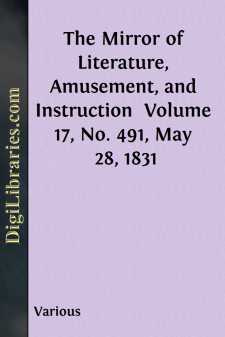Categories
- Antiques & Collectibles 13
- Architecture 36
- Art 48
- Bibles 22
- Biography & Autobiography 813
- Body, Mind & Spirit 142
- Business & Economics 28
- Children's Books 15
- Children's Fiction 12
- Computers 4
- Cooking 94
- Crafts & Hobbies 4
- Drama 346
- Education 46
- Family & Relationships 57
- Fiction 11828
- Games 19
- Gardening 17
- Health & Fitness 34
- History 1377
- House & Home 1
- Humor 147
- Juvenile Fiction 1873
- Juvenile Nonfiction 202
- Language Arts & Disciplines 88
- Law 16
- Literary Collections 686
- Literary Criticism 179
- Mathematics 13
- Medical 41
- Music 40
- Nature 179
- Non-Classifiable 1768
- Performing Arts 7
- Periodicals 1453
- Philosophy 64
- Photography 2
- Poetry 896
- Political Science 203
- Psychology 42
- Reference 154
- Religion 513
- Science 126
- Self-Help 84
- Social Science 81
- Sports & Recreation 34
- Study Aids 3
- Technology & Engineering 59
- Transportation 23
- Travel 463
- True Crime 29
The Mirror of Literature, Amusement, and Instruction Volume 17, No. 491, May 28, 1831
by: Various
Categories:
Description:
Excerpt
AMPTHILL HOUSE, THE SEAT OF LORD HOLLAND.
This is a delightful retreat for the statesman and man of letters—distinctions which its illustrious occupant enjoys with high honour to his country and himself.
Ampthill is throughout a never-tiring region of romantic beauties. These were sung in some lines of great sweetness and poetical feeling, a few years since by Mr. Luttrell, who appears to have taken his muse by the arm, and "wandered up and down," describing the natural glories and olden celebrity of Ampthill. We remember to have read his "Lines" with unmixed pleasure.
The Engraving is copied from one of a Series of "Select Illustrations of Bedfordshire;" the letter-press accompaniments being neatly written by the Rev. I. D. Parry, M. A. author of the "History of Woburn." Ampthill follows.
Ampthill House, now the seat of the Right Hon. Lord Holland, is a plain but very neat edifice, built of good stone. It was erected by the first Lord Ashburnham, then the possessor of the estate, in 1694. It is situated rather below the summit of a hill, which rises at some little distance behind, and much less elevated than the site of the old castle, but has still a commanding situation in front, and is sufficiently elevated to possess a great share of the fine view over the vale of Bedford. It is also well sheltered by trees, though the passing traveller would have no idea of the magnificent lime alley, which is concealed behind it. The house has a long front, abundantly furnished with windows, and has two deep and projecting wings. In the centre is a plain angular pediment, bearing the late Lord Ossory's arms, and over the door is a small circular one, pierced for an antique bust, and supported by two three-quarter Ionic pillars. In this house is a small collection of paintings, &c., principally portraits.
At the foot of the staircase is a large painting, formerly in fresco at Houghton House, which was taken off the wall, and put on canvass by an ingenious process of the late Mr. Salmon. It represents a gamekeeper, or woodman, taking aim with a cross-bow, full front, with some curious perspective scenery, 6 feet by 9-1/2 feet. We have heard a tradition, that it is some person of high rank in disguise; some say James I., who was once on a visit at Houghton. From the propensities of "gentle King Jamie," this is not unlikely.
The pleasure ground at the back of the house, commands a pleasing, extensive view; beyond this is the lime walk, which is certainly one of the finest in England.—It is upwards of a quarter of a mile in length, the trees in some parts, finely arching; and may be pronounced, upon the whole, superior to any walk in Oxford or Cambridge.
The park in which this house stands, is well known, from many descriptions, to be a singularly picturesque and pleasing one. It is, at the same time, a small one, but the dimensions are concealed by the numerous and beautiful groups of trees with which it is studded. The oaks are particularly celebrated for their great size and age, several of them are supposed to be upwards of 500 years old, and some do not hesitate to say 1,000 years; the girth of many of them is ten yards, or considerably more....












